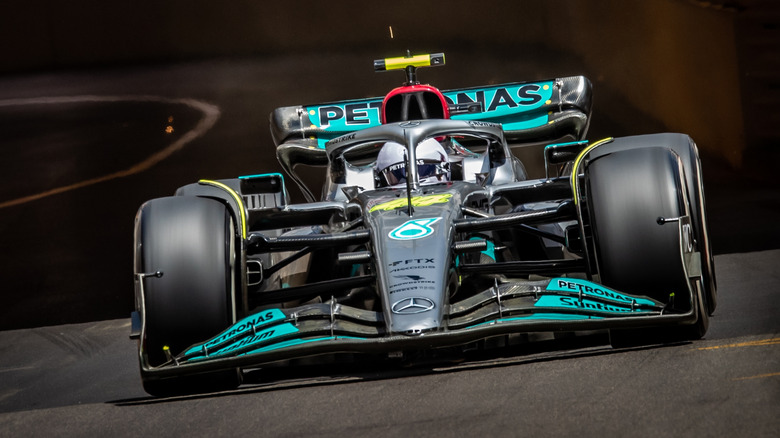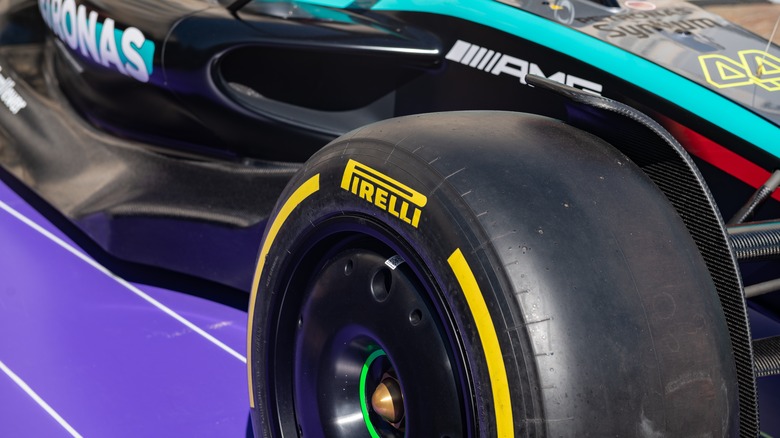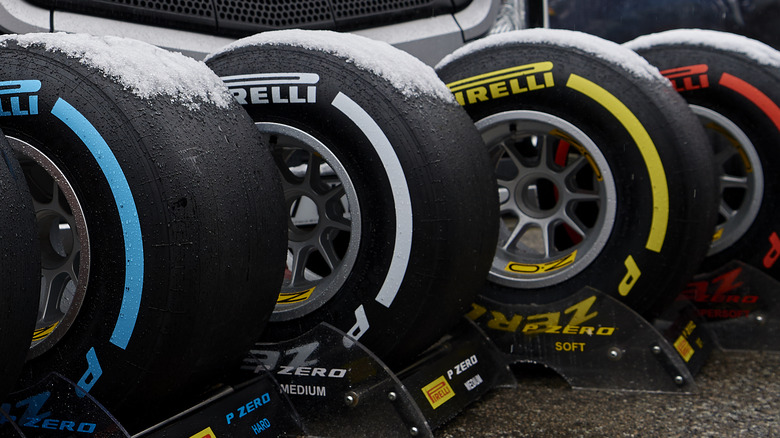What Happens To Used F1 Tires After A Race? You Might Be Surprised
There are more layers to the world of Formula One racing than meet the eye. Beyond the cutting-edge automobile engineering, split-second reflexes, and raucous fan interactions, F1 racing is an early preview of the innovation, some of which are already revving inside modern-age cars or will go mainstream in a few years from now. The humble car tire, for example, also owes some of its tricks to the engineering magic that happened on a track. But when it comes to those wide and bulky tires in F1 cars, those are special for more reasons than one.
They wear out pretty fast, and considering the amount of money floating around, you might think these tires are conveniently discarded. On the contrary, every tire is closely tracked using a unique identification system and then properly recycled. In fact, fines are imposed for losing the tires, and the used units are taken to the fiery pits of an incineration chamber in unmarked trucks. "It's why they don't sell their tires to the race teams, they lease them," says a report from WIRED.
This is the stage where they get a new life. The controlled burning of used F1 tires results in by-products that are used elsewhere, and some of them go into making fresh F1 tires, too. Using a process called pyrolysis, brands like Bridgestone plan to recover materials such as carbon black and oil, both of which are used as raw materials for making new tires and even building materials.
The secretive side of recycling
Pirelli is the official tire supplier for Formula 1 cars, and has maintained that status since 2011. The partnership was renewed in 2025 and extends through the 2027 racing season. There is, however, no dearth of tire brands eager to replace Pirelli. Names like Michelin, Goodyear, and Bridgestone are right around the corner and would eagerly lap up the next plum contract. Needless to say, the competition is unforgiving, and the only way to stay at the top is relentless innovation. You don't want your technology to fall into the hands of a rival.
"From day one, we collected all the tires, for confidentiality of course, but also to have the possibility to recycle them in a sustainable way. And for some years, we recycled all the tires from F1, F2 and F3, creating energy from them," Pirelli boss, Mario Isola, told the official Formula One media channel. In the realm of Formula One tires, the stakes are so high that every bit and scrap left on the track is diligently scooped up.
It is, therefore, imperative that the used tires are also carefully picked up, shredded, and recycled to ensure that the chemical secrets behind making them remain a secret. "Using 'secret materials' for the manufacture of our tires, we don't want to give away our intellectual property. That's why we collect all sets made available to the drivers at the end of all Formula 1, Formula 2, and Formula 3 sessions." Isola was quoted as saying.
Recycling, to a new birth
Pirelli is currently supplying FSC-certified F1 tires, which include at least 15% sustainably sourced natural rubber. Other components include synthetic rubber, metal wires, and a variety of other chemicals such as silica, sulfur, and carbon black in different proportions. The first step in the recycling journey is using the chunks of shredded tire material as fuel in brick kilns instead of conventional materials like coal. On a per unit mass basis, these tires can produce equivalent, or more heat than petroleum-derived oils and coal, while producing less harmful gases. The burnt residue leaves an ash-like material called carbon black, which goes back into making new tires.
Another alternative approach entails using a powdered form of the used tire material for making playground turf, asphalt, and rubber mat. "At the moment, we recycle all the tires. There are also projects in the works to recycle the tires to create plastic materials, flooring, and for use in asphalt. For the future, we have a couple of projects that are super confidential, but very, very nice," the Isola told AutoWeek.
It appears that the circular approach for reusing tire material is very much in place. Just over a year ago, Isola told Formula1.com that all the tires supplied by Pirelli to the F1, F2, and F3 leagues are eventually turned into secondary materials for applications such as flooring. The company, however, is looking to make the whole process even greener and sustainable using advanced technology in the coming years.


